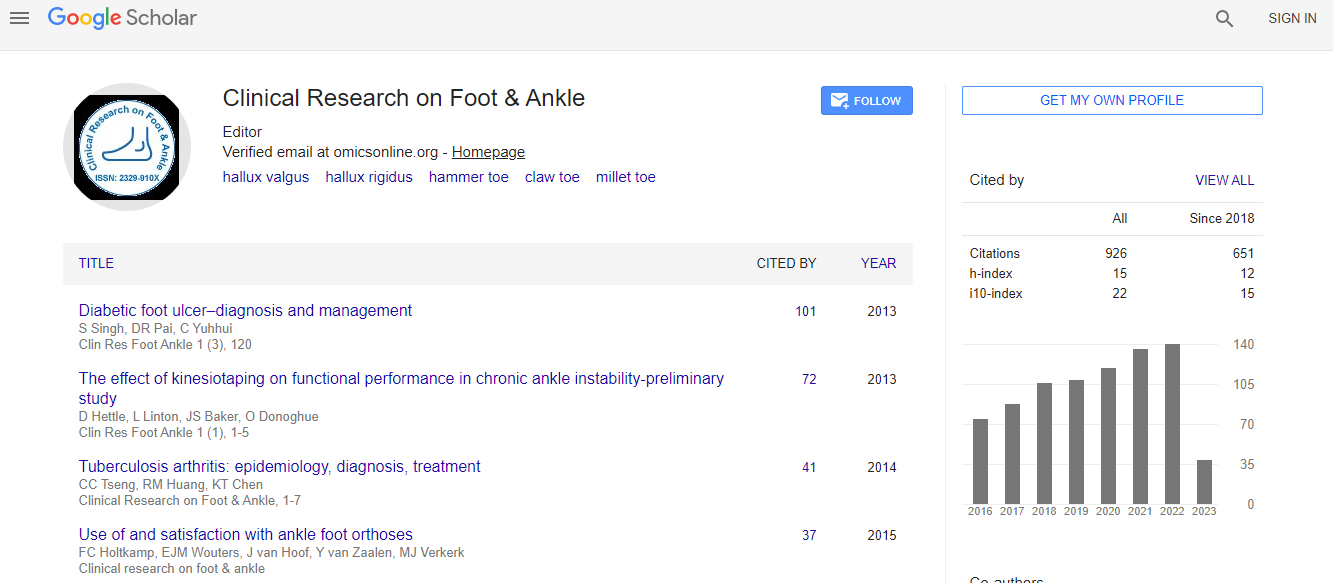Review Article
Closed Reduction & Percutaneous Fixation of Lisfranc Joints Injuries: Possibility, Technique & Results
Sherif Mohamed Abdelgaid*, Mahmoud Salah, Samir Abdulsalam and Farid AbdulmalakConsultant Orthopedic Surgeon, AL-Razi Orthopedic Hospital, Kuwait
- *Corresponding Author:
- Sherif Mohamed Abdelgaid
Consultant Orthopedic Surgeon
AL-Razi Orthopedic Hospital, Kuwait
Tel: 0096524898124, 0096599539270
E-mail: Sherifmaa@yahoo.com
Received Date: January 17, 2013; Accepted Date: April 29, 2013; Published Date: May 03, 2013
Citation: Abdelgaid SM, Salah M, Abdulsalam S, Abdulmalak F (2013) Closed Reduction & Percutaneous Fixation of Lisfranc Joints Injuries: Possibility, Technique & Results. Clin Res Foot Ankle 1:109. doi: 10.4172/2329-910X.1000109
Copyright: © 2013 Abdelgaid SM, et al. This is an open-access article distributed under the terms of the Creative Commons Attribution License, which permits unrestricted use, distribution, and reproduction in any medium, provided the original author and source are credited.
Abstract
Introduction: Lisfranc joint injuries are the most common injuries of the midfoot. Injuries include (1) pure Lisfranc joint dislocations, (2) Lisfranc joint fracture dislocations, (3) combined Chopart-Lisfranc joint fracture dislocations, (4) complex Lisfranc joint fracture dislocations with entrapped tibialis anterior tendon and (5) segmental Lisfranc fracture dislocation with concomitant fracture metatarsal neck or head or dislocation of metatarsophalangeal joints. Treatment options vary from closed or open reduction followed by K. wires, screws or plate fixation or primary arthrodesis.
Material and Methods: 35 patients with 37 cases of Lisfranc’s joint injuries were treated in Al-Razi orthopedic hospital, Kuwait during the period from January 2006 to December 2010. Injuries were classified using Hardcastle classification. Closed reduction was tried first followed by percutaneous fixation with cannulated 3.5 mm screws for medial 3 joints & K wire fixation for lateral (4th & 5th) TMT joints. Closed reduction was failed in 5 cases and open reduction was performed.
Results: Functional results were assessed clinically using AOFAS Midfoot rating scale. The mean follow up period was 24 to 48 months (mean, 38 months). Excellent results were obtained in 15 cases 40.5%; results were good in 15 cases 46%; % fair results obtained in 3 cases 8% and poor results in 2 cases 5.5%.
Conclusion: The associated soft tissue injury with Lisfranc joint injury may interfere with surgical treatment of the injury increasing the risk of wound complications like wound dehiscence and deep infection. Early diagnosis of Lisfranc joint injuries allows closed or percutaneous reduction and fixation before massive soft tissue swelling. This minimally invasive treatment decreases the complication rate and allow early rehabilitation compared with the traditional method of open reduction. However open reduction is indicated in cases of complex Lisfranc injury with entrapped tibialis anterior tendon and in combined injury of Lisfranc joint with Chopart or metatarsophalangeal joints to avoid worse results associated with closed or percutaneous reduction in these types of injuries.

 Spanish
Spanish  Chinese
Chinese  Russian
Russian  German
German  French
French  Japanese
Japanese  Portuguese
Portuguese  Hindi
Hindi 
